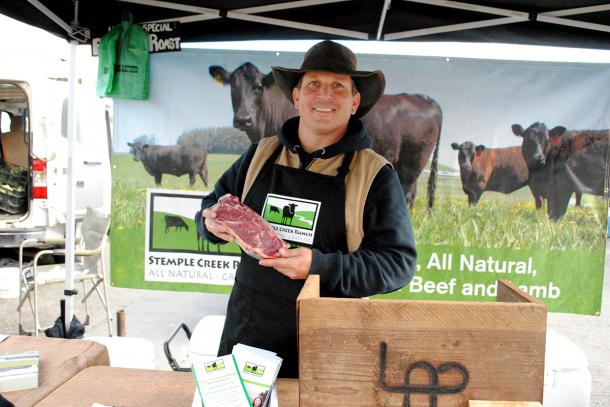Choosing Grass-Fed Meat
July 3, 2015

One of the many benefits of buying meat from the farmers market is that you can talk to the rancher or butcher about how the animals were raised, and ask for recommendations on which cuts to buy based on your budget and skills. Don’t be shy! They love answering your meaty questions.
We spoke with fourth-generation Loren Poncia at Stemple Creek Ranch about his meat buying and grilling tips.
 CUESA: Tell us a bit about your ranch and how your livestock is raised.
CUESA: Tell us a bit about your ranch and how your livestock is raised.
Loren Poncia: I’m a fourth-generation rancher. My family has been on the same ranch for about 115 years. We raise high-quality beef and lamb within five miles of the Pacific Ocean. It has a different flavor, since our animals eat grass that takes in the salty air. We specialize in fatty grass-fed beef and lamb, but we also have cuts of beef that are leaner. Our main ranch is in Tomales, which is 55 miles from the Ferry Plaza. We also have ranches in Point Reyes, Elk, and Humboldt. The pasture is certified organic. Most of our animals live to be 24 to 28 months old, and they eat grass and their mothers’ milk with a small amount of hay, most of which is produced on our farm.
CUESA: As a pasture-based rancher, how is the drought situation on your ranch?
LP: Grass-fed cattle drink water and there’s water in the grass they eat. They’re not sitting in a feedlot eating corn and soy and all the other crops that take a lot of irrigation water to grow. We’re dry-land farmers. We try to make sure our soils have a lot of carbon and organic matter in them so that the rain stays on our land and doesn’t wash down into the ocean. This is the fourth year of the drought, so it’s not something new to us. We for sure don’t have it down, but by planning aggressively ahead of time, we feel pretty comfortable that we’re going to have a good supply into the winter. But we need rain badly, and the state needs it badly.
CUESA: Do you have any tips for buying and grilling grass-fed beef?
LP: It really depends on the cut of meat, but I love to get the grill really hot. I let the meat come to room temperature, then I rub it with olive oil and season with salt, pepper, and garlic. I sear the outside, let it cook to medium rare, and let it rest f0r 10 to 15 minutes, which makes a significant difference in the eating quality. Grass-fed beef cooks faster, so I always try to undercook it. Then I can put it back on the grill and cook it more if I need to.
Carne asada, Korean-style short ribs, and traditional burgers are easy and great. We also have rib-eyes, New Yorks, filets, and all that stuff, too. Top sirloin is the best value. It’s the cheapest best steak out there in my opinion. It’s a little leaner than a rib-eye, but it’s delicious. There are some other cuts you might want to try, like the flat iron, velvet steak, oyster steak, or spider steak. There’s only about a pound per animal, but they’re delicious cuts.
I’d say the most important thing is to buy something that you’re comfortable cooking and that you really enjoy. We usually have pieces of meat for all different skill sets. One of us at the farmers market can tell you how to cook it, if you’re not sure, and most of our recipes are super simple and delicious. A lot of people in San Francisco don’t have a grill, so they use a cast-iron skillet or a small oven. Not having a grill is no reason not to eat high-quality meat.
Stemple Creek Ranch cattle photo by Karen Pavone @farministasfeast.
Topics: Culinary, Farmers market, Holiday, Meat/poultry
